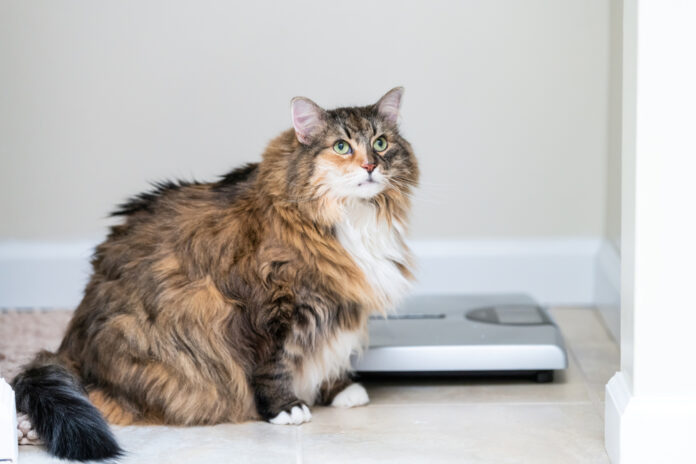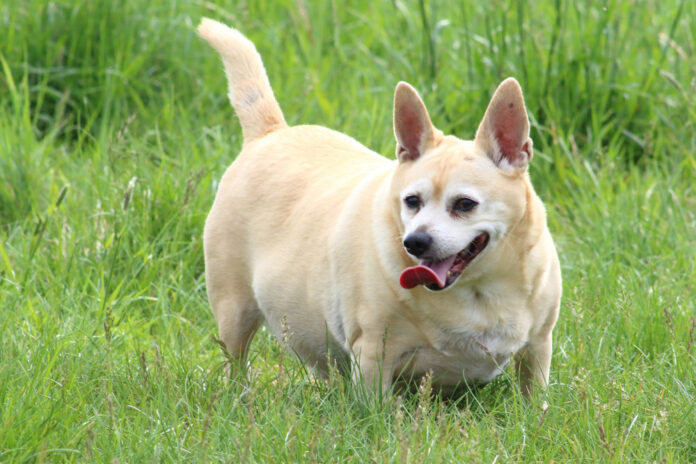Superfoods from the sea – they’re good for dogs and cats!

From dulse to wakame, sea vegetables are packed with nutrition. Try these tasty and healthy recipes on your animal companion.
Did you know that seaweeds are among the oldest forms of life on earth? They’re also regarded as superfoods, rich in nutrients, and make a healthy addition to your dog or cat’s diet as well as your own. Let’s look at what sea vegetables offer, and how you can serve them up to your animal family.
A little background
Juliette de Bairacli Levy, the “mother of herbal medicine” for animals, first introduced seaweed to the veterinary community in the early 1930s. However, the use of sea vegetables in human cultures dates back much further. Archeology has demonstrated that seaweeds have been included in human diets for at least 10,000 years. The ancient Chinese used kelp and other seaweeds as medicine, while these marine plants have been integral to Japanese cuisine for over 1,500 years. The ancient Greeks used kelp to feed their cattle; the people of Iceland used kelp as a food staple; and ancient Hawaiian nobles grew gardens of edible seaweeds. In Europe and Great Britain, meanwhile, kelp was used as a fertilizer to feed soil and support plant growth.
It’s estimated that our oceans are home to more than 8,000 species of seaweed. Unlike land plants, sea vegetables have no leaves, stalks or roots, so their growth depends on energy from the sun.
Sourcing seaweed
Look for sustainably-harvested, low-temperature, sun-dried, OCIA (Organic Crop Improvement Association) standard sea vegetables, which have been tested for heavy metals, herbicides, pesticides, PCBs, fuel oil and bacteriological contaminants. OCIA is a non-profit, member-owned agricultural organization that’s dedicated to providing the highest quality organic certification services and access to global organic markets. It’s also committed to environmentally-sound stewardship.
Fresh sea vegetables should be washed and stored in the refrigerator, and cooked in ceramic pots, glassware or stainless steel. Dried sea vegetables should be stored in dark glass jars or hung in dark dry rooms.
Sea vegetable shopping list
1. Acadian sea kelp
Acadian sea kelp contains protein, iodine, calcium, sulphur, magnesium, iron, copper, phosphorus, sodium and potassium, along with vitamins A, B, E and D. This type of kelp comes from the North Atlantic coast of Canada. Trained harvesters hand-rake the marine plants under closely-controlled conditions to ensure purity and freshness, and to safeguard this precious natural resource. The fresh seaweed is dried using gentle passive solar drying technology to preserve its nutritional benefits.
Kelp, including Acadian sea kelp, is the richest single source of trace minerals. Pituitary, adrenal and thyroid glands benefit from these trace minerals. Kelp supports the immune system, helps regulate blood sugar levels, soothes the gastrointestinal tract, and helps alleviate joint pain. Kelp reduces cholesterol levels by inhibiting bile acid absorption. It also helps flush harmful bacteria from the bladder, reduces inflammation in injured tissues, and supports skin and coat health.

2. Dulse
Also known as sea parsley, dulse is a red sea vegetable. Its history of use dates back 14,000 years. Dulse grows attached to rocks on both sides of the North Atlantic and Northwest Pacific coasts. It is picked by hand at low tide and left to dry.
Dulse is a rich source of iron, potassium, iodine, vitamin B6, riboflavin and dietary fiber. It also contains protein, floridoside (a type of carbohydrate), calcium, fluoride, magnesium, copper, zinc, manganese, chromium and vitamins C and E. The natural iodine in dulse supports thyroid function.
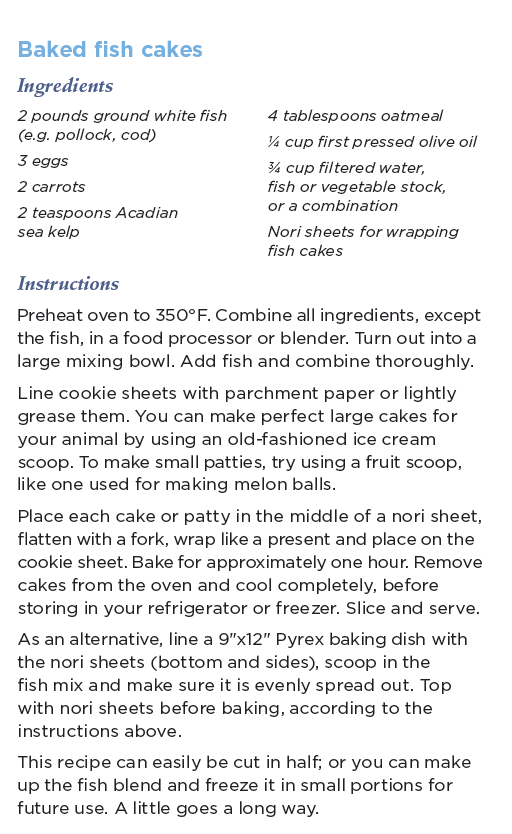 You can use dulse as a substitute for regular table salt, serve it alongside dark leafy vegetables, or toast it for a great crunchy treat your animals will love.
You can use dulse as a substitute for regular table salt, serve it alongside dark leafy vegetables, or toast it for a great crunchy treat your animals will love.
3. Kombu
Kombu is a type of kelp, also called Laminaria digitata, setchelli and horsetail kelp, since that is exactly what it looks like. It is the largest of the sea vegetables, growing up to 1,500 feet. Kombu kelp is a meaty high-protein seaweed that supports liver, stomach and kidney function. It contains iodine, carotenes, vitamins B, C, D and E, calcium, magnesium, potassium, silica, iron and zinc. It’s also higher in natural mineral salts than most other seaweeds. Kombu also contains glutamine and fucoidan, a complex polysaccharide. It supports kidney and thyroid function, and even acts as a natural fungicide. Japanese studies have shown that when fucoidan is administered to cancer cells in a Petri dish, the cells are destroyed within 72 hours through a self-induced process called apotosis.
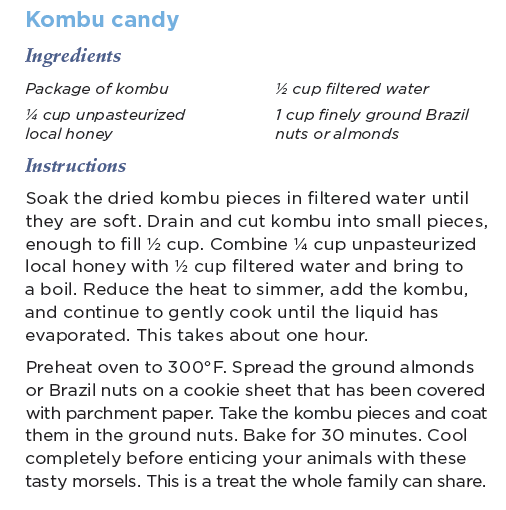
Kombu kelp combines well with carrots and squash, for a nutritional meal topper. Chicken and beef stocks can be replaced with a stock made from kombu, for a powerful nutritional punch. You can also add it to bone broths. Simply soak dried kombu pieces in filtered water until they are soft. Drain and cut the kombu into small pieces, and add ½ to 1 cup to your broth.
Soaked, simmered, sautéed, roasted, pan-fried or marinated, kombu is a great addition to the whole family’s diet.
5. Nori
Nori (Porphyra yezoensis) contains a significant amount of protein, vitamins A, B and C, minerals and amino acids, including arginine, typically found in animal protein. Other amino acids that nori offers include alanine, glutamic acid, which helps support the gastrointestinal tract and aid in the digestive process, and glycine. This sea vegetable also contains a significant amount of taurine, which provides liver and cardiovascular support.
Nori sheets are low in sodium, but boast high levels of dietary fiber, magnesium, potassium, riboflavin and vitamins A and C. Try spreading nori sheets on a cookie sheet covered with parchment paper and bake them in a preheated 300°F oven for five to ten minutes. Sprinkle some on your animal’s food before serving. Nori can also be dry roasted on your stovetop for a crunchy treat.

5. Wakame
Otherwise known as Undaria pinnatifida, wakame is a brown seaweed and one of the most popular foods from the sea. It has been eaten in Japan and Korea for centuries. Wakame contains a compound called fucoxanthin, which has many benefits, including the oxidation of fatty acids and the production of heat energy in fat tissue mitochondria, creating energy from sugar and fatty acids, and regulating metabolism, making this sea vegetable helpful to diabetics.
Wakame is a rich source of eicosapentaenoic acid, an Omega 3 fatty acid, and also contains high levels of calcium, iodine, thiamine and niacin. It’s a source of chlorophyll, protein, magnesium, iron and dietary fiber. In fact wild Atlantic wakame (Alaria) contains more dietary fiber than oat bran.
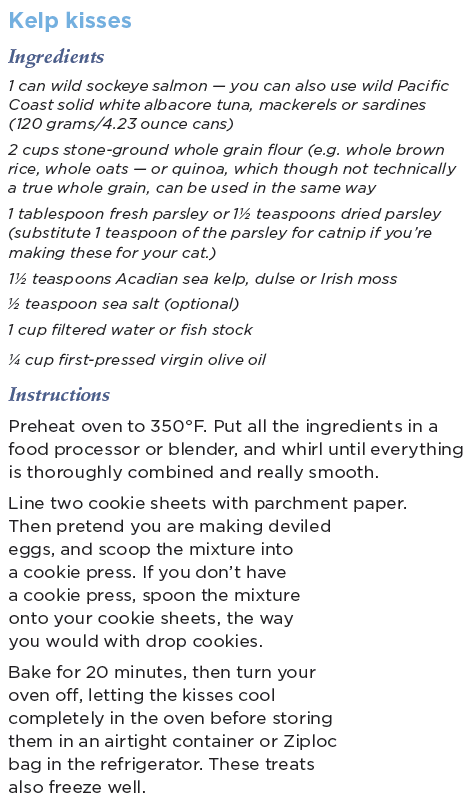
In traditional Asian medicine, wakame is used to purify the blood, aid in liver detoxification, and support the gastrointestinal system and reproductive organs. Research indicates that wakame helps contribute to healthy skin and coat in animals, and has anti-carcinogenic properties.
6. Irish moss
Irish moss makes a perfect “supersprinkle” for your dog or cat’s food. It provides glandular and lung support and soothes the gastrointestinal tract. It also contains calcium chloride, which acts as a heart tonic and provides support to the kidneys and bladder.




